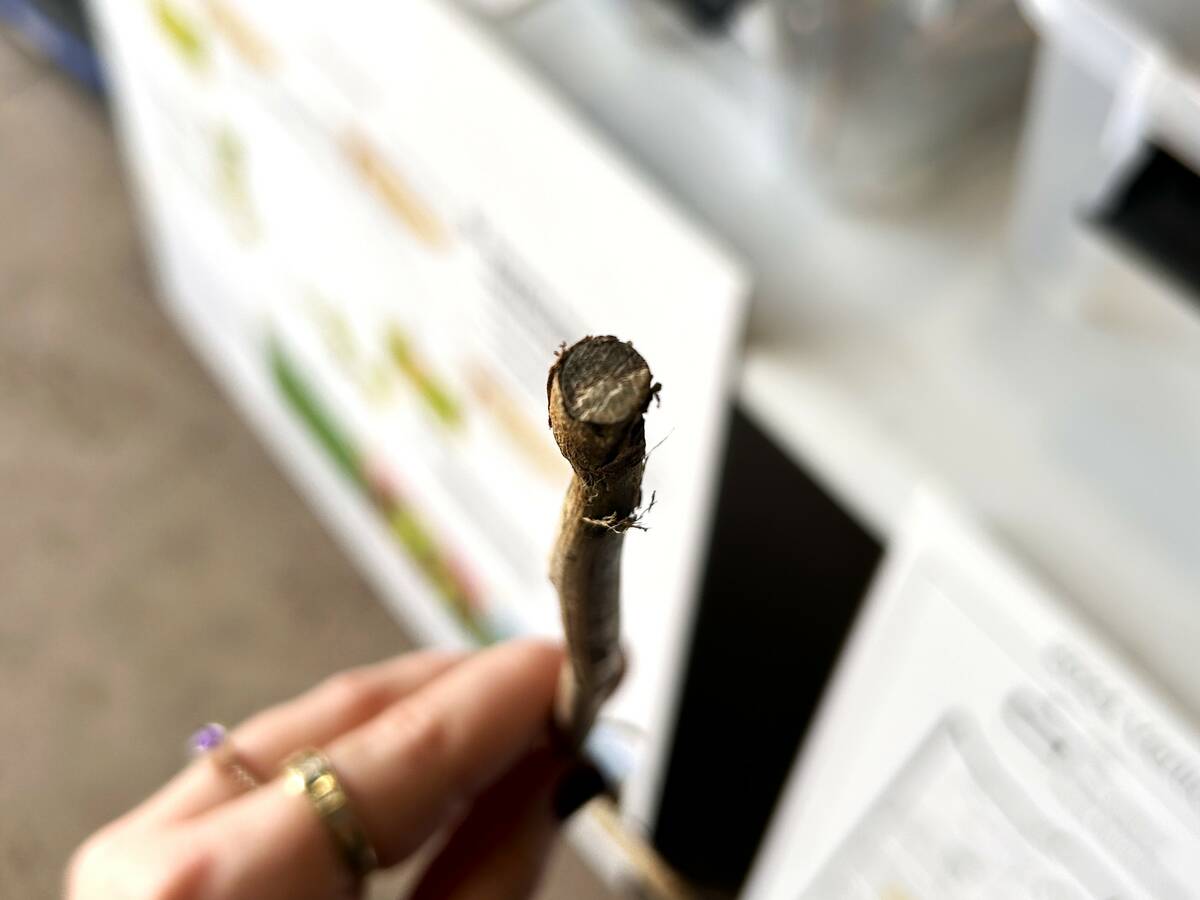There are two places to mine phosphorus.
One is the rock phosphate mines that supply the world with raw materials for phosphorus fertilizer. The other is in agricultural soils where cropping depletes the nutrient, and once it’s gone, it’s gone.
“We have a phosphorus problem in agriculture and in society because we rely heavily on phosphate rock deposits to create our fertilizers,” said Joanne Thiessen Martens, a soil scientist at the University of Manitoba, during this winter’s Manitoba Agronomists’ Conference.
Read Also

Manitoba canola embattled by verticillium
Verticillium stripe pressure has been growing in Manitoba, and canola farmers still have precious few tools to protect their crop from the disease.
“Phosphorus is a non-renewable resource and we really have to find ways to recycle it from all those different waste streams back to our agricultural land.”
That’s the heart of the phosphorus problem. Unlike nitrogen, it can’t be derived from the atmosphere. It comes from a limited supply of phosphorus rock.
Livestock manure is one of the traditional sources for phosphorus recovery when used on cropland. Pulling it from sewage disposal systems is another area being explored.
“One of the most promising ways of recycling human waste nutrients back to agricultural land is through extraction of struvite from municipal waste water,” Thiessen Martens said.
“It’s a magnesium ammonium phosphate crystal that forms spontaneously in the pipes of wastewater treatment plants when you have high nutrient concentrations in the liquid with the correct pH.”
It forms so readily in pipes of all kinds — including biological ones — that some people are all-too-familiar with these crystals in the form of kidney stones.
They’re not as painful in a municipal sewage system but can still wreak havoc. The crystals concentrate in waste water and at the right pH level, they form a scale inside pipes that can eventually block them and require removal.
“So that’s part of the impetus for some of these wastewater treatment plants wanting to get rid of this stuff at some other stage of the process rather than having it build up in pipes,” Thiessen Martens said. “The great thing about struvite extraction is that it yields a product that is useful as a fertilizer.”

Ostara, out of Vancouver, is one Canadian company marketing Crystal Green, a fertilizer product based on struvite. It has a 5:28:0 NPK analysis along with an additional 10 percent magnesium and comes in an easy to use granular formulation. Its water solubility is low but it becomes soluble when exposed to plant root acids.
“Despite that slow solubility, the crop response to this stuff seems to be pretty good and in studies comparing it to a soluble fertilizer, struvite will perform equally well,” said Thiessen Martens, adding that many factors affect how it performs.
Soil pH is a big one, along with fertilizer particle size. In high pH alkaline soils, the larger granules dissolve more slowly because they’re soluble in acid. The crop response can be significantly reduced.
Crop type may also make a difference and there has also been research on temperature and soil texture.
A few years ago, University of Manitoba soil scientist Francis Zvoyama and grad student Yeukai Katanda used struvite extracted from hog manure in a greenhouse study. They looked at how canola, with wheat in sequence, responded to struvite compared to mono ammonium phosphate (MAP).
“In that first crop phase, struvite and MAP produced a similar canola yield but in the second and third phases the struvite actually produced a greater amount of biomass than the MAP,” Thiessen Martens said. “So there’s a little bit of support for that idea, that struvite can provide a longer-term supply of phosphorus compared to a soluble fertilizer.”
In her own research, Thiessen Martens worked with granular struvite fertilizer in a mixed alfalfa-grass stand near Libau.
“We went in the spring of 2017 to an established stand, drilled in the struvite for a one time application and then monitored over three years to get at that long term pattern.” she said.
“In 2018 the strength of response to the struvite application rate was actually increasing with time.”
When she looked at forage biomass in the final year and separated it into its components, she found that the alfalfa had a stronger response than the grass.
“This will probably happen with other phosphate fertilizers too, but it does speak to the importance of phosphorus nutrition for those forages,” she said.
“We don’t want to draw any broad conclusions on this yet but it makes us ask whether struvite can increase Olsen P, that indicator of how the plants might respond to phosphorus, without increasing phosphorus loss.”
Struvite shows potential as a fertilizer on its own or as part of a blend. Using it effectively will require more research on how it behaves in various soil types, under different conditions with different crop types.
Phosphorus may cycle several times in cropping systems but there’s still net downhill travel before it’s lost to the oceans. Producing and using wastewater-based struvite is a way of closing that nutrient loop.
“If we could recycle that perfectly back to agricultural land, it could replace eight percent of the imported fertilizer that we use,” Thiessen Martens said.
“Clearly that’s not a huge amount of it compared to the EU, where they could replace more than 50 percent of their phosphorus needs just by recycling their human phosphorus. But every bit counts and I’m a big believer in taking those steps to improve these systems in whatever way we can.”















